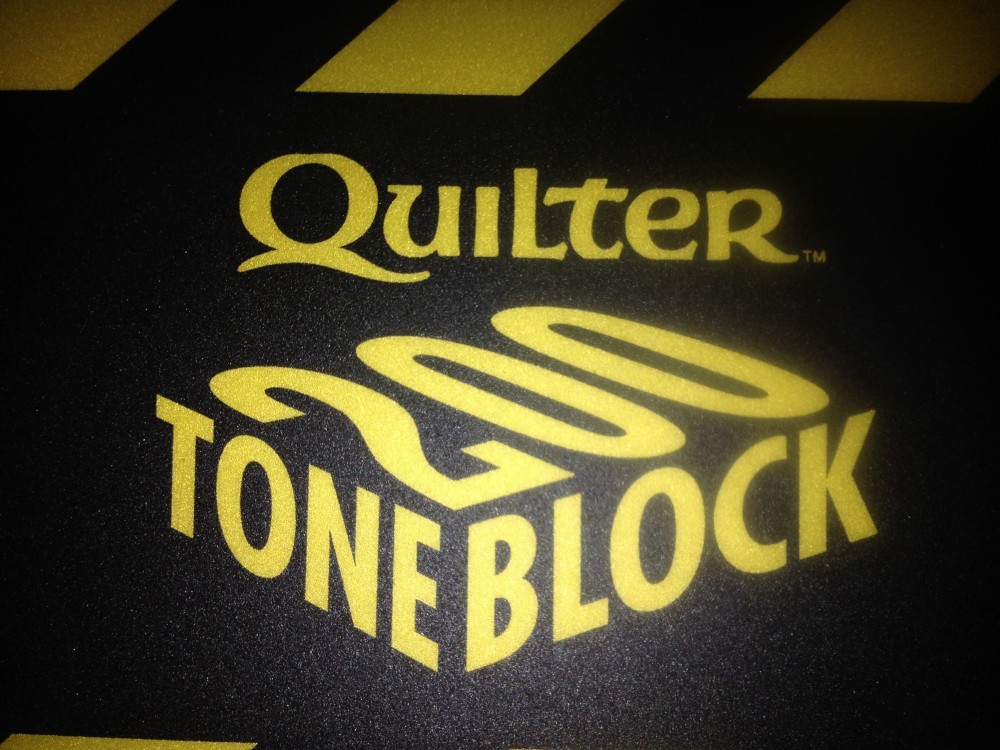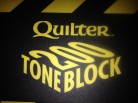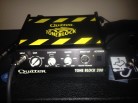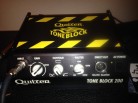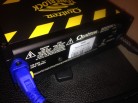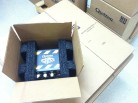First Impressions
Usually when I get an amp for testing it comes in a sizable box. I've received text books in the box that the Tone Block 200 came in. Moreover, the weight was very light. Once I opened the box I was greeted to a lot of bubble wrap surrounding the Tone Block, a cable to hook the amp up to a speaker cabinet, the power cord, and the owner's manual. This was a pre-production unit so Chris Parks from Quilter was nice enough to include a photo of the current packing. The manual itself is not the exhaustive manual that came with the Aviator I reviewed. This manual keeps the trimmed down theme going. Only 10 pages long and packed with everything you need to know about this innovative concept.
The Tone Block 200 itself is very well built. Metal construction is very much appreciated. Obviously this doesn't mean you should abuse it but its strong construction makes it much more likely to survive a drop than your average wood cabinet head. A high quality black paint is applied to the metal. On top we have a large Tone Block 200 sticker identifying the unit and on the front we have silk screened lettering for the controls. Holes are strategically placed on the metal case to let you bolt two Tone Blocks together. Why would anyone need that? How about tying two of these amplifiers together to get up to 400 watts? Better yet, I'd say break your signal into stereo, adjust the amps slightly differently or identically, and power two cabinets on opposite ends of the stage for real stereo sound. Any way you look at it you have more options with a Tone Block. The holes can also be used to help you bolt your Tone Block into your rack if that's how you fly.
The controls themselves are: Input, Gain, Contour, Master, Direct Out, and the Power switch. No tone stack, reverb, channel select, or boost circuits can be found. More on this later, but in case you are getting nervous let me assure you this is a very good design. On the back are two outputs: 4 and 8 ohms. Also on the rear is the power cord connection. Again a locking IEC power cord connection is used just like on the aviator. This locking design eliminates one possible problem encountered during shows.
Operating the Amplifier
On the gain control you may notice that the controls are labeled in a scale from Line to Guitar. What does that mean? If you are already using a preamp to get your tone or have an EQ you aren't looking to have another tone stack in the mix. Swing that sucker over to Line and use your other gear to dial in your tone. What if you are a guy like me that likes to get his tone plugging directly into the amp? I found that the gain on this knob works just like any other gain knob with a caveat: the contour control. I loved the contour control on the Aviator amplifier and it works just as well on this amp. I'll get more in depth further in the review with specific tones.
Interestingly the Master control is labeled in increments of power output: 0w, 10w, 40w, 100w, and 200w. Notice that halfway on the dial the output is 40w and not the expected 100 watts. This means this is a logarithmic control. This lets you have more fine control at the lower output levels and lets you quickly move from 100 watts to the max 200 watts. Would a linear control be put in you'd have a tough time moving from 0 watts up to 5, and then 10, and so on. These are the kind of touches I really like about Pat Quilter's designs. As it was, I found anywhere from 5 to 10 watts gave me a fantastic amount of power for practicing and the higher outputs were only necessary for performances.
The Direct Out offers a great way to record your work. Quilter goes the extra mile and equalizes the signal to match the response of a speaker. What does that mean? Often if the output isn't designed this way you'll get a very unrealistic sounding tone in your recordings. The connector itself is a standard three pin microphone cable connection. This is a very standard connector in PA systems and makes sure you don't need adapters from the connector to your cable. Most locations with PA systems are already pre-wired to use these types of cables.
So having a 4 ohm and 8 ohm output limits you in cabinets right? Actually the manual has this little caveat: "Other impedance may be connected, but the tone may change somewhat and the front-panel wattage markings may no longer be accurate." To that end I used one 4x12 cabinet loaded with Jensen speakers running at 8 ohms and another loaded with Greenback copies running at 16 ohms. Depending on what type of music I'm playing I can hit most tones between these two cabinets. In the case of a tube amp you can't use an unusual resistance without risking damage to your amp. I wouldn't try 32 ohms resistance since that is a huge difference in resistance, and really, are there any amps designed for 32 ohms operation? You can theoretically wire a cabinet that way but that wouldn't be a great idea.
The Tone
So I'm sure you are tired of reading about specs and want to know what it sounds like. I linked to a video at the end of the review with many lustrous clean tones. The clean tones are as amazing as I found they were with the Aviator. What about the gain you probably want to know? This amplifier can do everything from blues to gritty and all the way to rock tones. Throw in an overdrive pedal and the preamp reacts just like a tube amp. Now we are totally in metal territory. None of this is any different than the Aviator I've used before. The trick with Pat's designs is that the contour and gain controls work wonderfully together. Go full on gain and put the Contour somewhere around 2 o'clock and you are in a thick heavenly tone. Roll that contour further clockwise and the loss of bass helps with that guitar tone. Like that modern metal sound? Roll the contour counterclockwise and you get a great mid scoop.
Whats even more apparent is that this amplifier loves pedals in front of it. Overdriven tones are fantastic - every bit as good as the Aviator but with only a contrast knob to work with you find a tone you like quicker. Seems counter intuitive. We've been sold the idea that we need further and further controls to get great tone for years. We were told that you had to have tubes and unless you had certain names on your amps your sound was going to be terrible. Along comes Quilter and shows that tubes aren't necessary for that tone we've been chasing. Furthermore, the Tone Block 200 shows that even in its most stripped down form a Quilter amplifier will outperform those big name amps with their tons of knobs and adjustments. If you find you can't get a tone right away perhaps an EQ ahead of this would work better?
One area where this amp can really soar is with modeling amplifiers or preamps. I have a Boss GS-10 which isn't a pedal setup but a small preamp with digital display. Its still pretty small for a preamp with 100 stock files and I've added about another 70. I find that when I put this preamp into the input of an amplifier the amps tone stack and design take over and my files sound nothing like what I think they should. If I use the preamp in the effects loop I also get so-so results. It seems to work better with amps that let me blend the original tone with the preamp tone of the GS-10 - I try to find a compromise between the preamp and the tone stack of the amp. My best results have been going directly to a power amplifier. The Tone Block 200 on its Line area of the gain control can function as a power amplifier. Hooking up my GS-10 I found beautiful results immediately. Whats even cooler is that more gain can be added if the Line sound isn't full enough. Bam - now I can adjust the tone for different rooms and environments easily.
In my last experiment I tried was hooking up the Tone Block 200 to a bass cabinet. I don't currently have a bass head but I do have a bass combo amp. I used the line out signal of the combo as the input to the Tone Block 200 which I used to hook up to the bass cabinet. Fantastic sound was not what I was expecting but exactly what I got. I love that the Tone Block 200 design doesn't change the tone you already have and like. It can enhance it and certainly having 200 watts handy is more than adequate for most situations. My bass cab is rated at 300 watts but you'll have to exercise caution as you can easily damage speakers with the 200 watts of power on tap with this amplifier.
Conclusions
The Quilter Tone Block 200 sounds every bit as good as the Aviator I've used previously but the Tone Block is smaller and is designed to work with pedal boards, preamps, and modeling amplifiers. This amp's small size and rugged construction are miles ahead of what other manufacturers are doing at the moment. More importantly, the sound comes first with Pat Quilter's designs. So would I change anything? My son's only remark was that he wishes it had a reverb. I thought about that but I actually like the streamlined designed. I personally wouldn't make any changes. What this does mean is that if reverb is a big part of your sound you'll need a reverb effect on your board or make sure you have it somewhere in your gear. The Tone Block 200 reminds me of old Fender designs. Simple, rugged, and tons of tone on tap. Amp designs have veered to the complex for so long its wonderful to see someone who has a totally new design that isn't a clone of an old design to reach this goal.
If all this isn't working for you then perhaps a normal head would be a better idea. With the Aviator and Micro Pro lines you can have multiple channels, reverb, and a more traditional layout and tons of other features. If minimalism and boosting the sound you already have are what you are looking for then the Tone Block 200 should fit the bill nicely. The Tone Block 200 starts shipping today (2-14-2014) so hopefully your Quilter retailer will have them soon to try.

